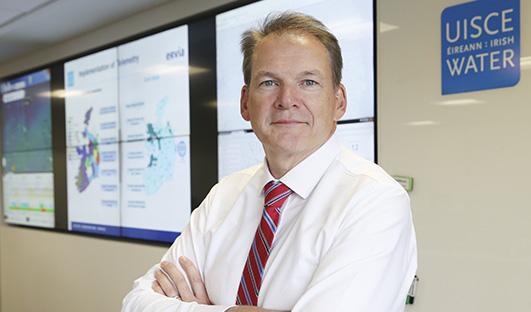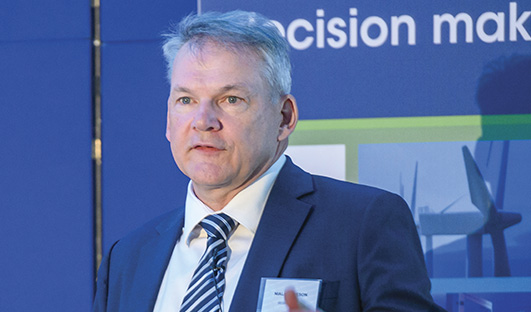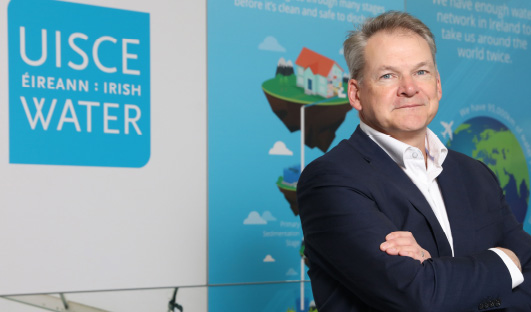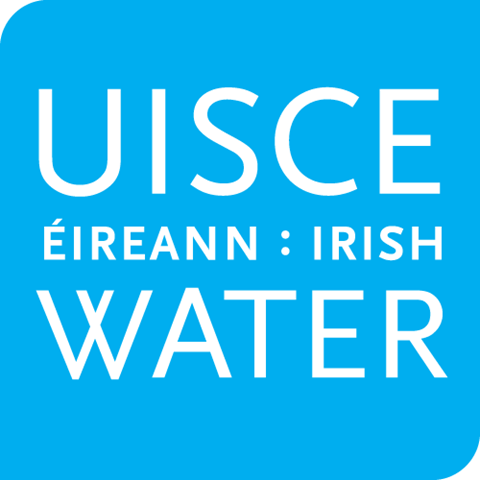Ambitious vision for the future delivery of Ireland’s water services

For Irish Water and its CEO Niall Gleeson, the coming years are set to bring significant change and exciting opportunities as the organisation progresses to become a national, standalone, regulated utility with full responsibility for the delivery of public water services in Ireland.
The recently published Water Services Amendment Bill creates the framework which will enable the legal separation of Irish Water from the Ervia group and follows the publication of the Framework for the Future Delivery of Water Services which provides for the voluntary transfer of local authority water services staff to Irish Water.
These two developments represent a generational shift in how public water services in Ireland are delivered, creating a national water services authority with the vision, resources and expertise to meet Ireland’s water and wastewater needs now and into the future.
While such an unprecedented organisational restructuring may seem daunting to many, for Gleeson managing change has been the one constant since he joined Irish Water in 2019, initially as Managing Director before being appointed CEO late in 2021. In his career as an engineer, he has worked on major infrastructure projects all over the world, from building power plants in Alaska to helping develop the Luas project in Dublin. He is relishing the opportunity to apply this expertise as he leads Irish Water into the next phase of its development.
“Irish Water is still a relatively young organisation, but it has undergone major changes and made huge progress, delivering significant benefits for Ireland,” he says.
“When Irish Water was set up there was a myriad of issues to be addressed as a result of decades of underinvestment in the water infrastructure: we had 50 towns and villages around Ireland where raw sewage was being discharged into the sea; there were thousands of people on long-term boil water notices; there were vastly differing procedures and charges for connecting to the water and wastewater network; and half of all treated water was being lost to leaks.
“Fast forward to 2022 and we have made huge progress in addressing many of those legacy issues. We have eliminated 60 per cent of all raw sewage discharges and are on track to end almost all the remainder by 2025; we have removed two million people from boil water notices, particularly long-term notices; working with the Commission for Regulation of Utilities (CRU) we have implemented standardised national charging regimes for connecting to the network and for non-domestic tariffs; and we are on track to reduce leakage to under 20 per cent in Dublin and 25 per cent nationally by 2030.

“I am confident that this track record, combined with the strong relationships we have built up with all of our stakeholders, will enable us to move forward successfully to the next stage on our journey to a single integrated public water services authority.”
“For the first time in Ireland, there is a coherent and ambitious vision for the delivery of water services at a national level. There is a place in Irish Water for all water services staff currently working in the local authorities, and we are ready to welcome everyone who chooses to join us.”
Niall Gleeson, Irish water
Strong, strategic vision for the future
With plans in place to address these urgent legacy issues, Gleeson’s focus now is on the future and realising the vision of becoming a world class public water service focussed on customer needs, efficient water services, and supporting housing, economic development and job creation across the country.
“We all know that good water infrastructure underpins economic growth and development. Our priority now is to build an organisation and an infrastructure that is fit for purpose to meet the country’s needs, while also enhancing the environment and safeguarding our precious water resources,” he says.
“Housing is a key priority for everyone and we recognise that we have an important role to play in enabling the delivery of new homes around the country. We have already delivered huge improvements in supporting water and wastewater connections by establishing a single national connections process that is fair and equitable for all applicants, irrespective of where they are in the country. We have grown our connection and developer services team to enable us to deliver a high-quality service to home builders and developers and we have also published water and wastewater capacity registers on https://www.water.ie/connections/developer-services/capacity-registers/. These registers provide guidance to developers and planners on which areas have capacity for growth.
“We recently launched new initiatives such as the self-lay in public roads and the experience-based contractor accreditation schemes to facilitate the development of water services infrastructure by contractors and to streamline the delivery of connections. All these initiatives are having a real impact; last year alone Irish Water approved connections for over 32,000 houses.
“We recognise that there is even further scope for improvement and we are constantly engaging with government, and with the construction sector and industry bodies such as the Construction Industry Federation (CIF) to find solutions to enable more efficient delivery of housing, while also making sure that the water services infrastructure meets the appropriate levels of quality and standards to avoid future issues for customers.”
Planning for a sustainable future
Ireland’s population is growing, and Irish Water must keep pace while also meeting the expectations of the public and its stakeholders. Gleeson points out that while water quality overall has improved, many supplies remain vulnerable due to the age and fragmented nature of the existing infrastructure.
“The most recent Census and forecasting on population growth tells us we will need 40 per cent more water by 2050 than we supply today. We have developed the first National Water Resources Plan (NWRP) to enable us to strategically and proactively plan for the country’s needs over the next 25 years and beyond. It will enable us to develop safe, secure, reliable, and sustainable public water supplies for all of our customers and communities, whilst safeguarding public health and the environment.”
An integrated national framework for the delivery of water services
The Framework for the Future Delivery of Water Services published by Minister for Housing, Local Government and Heritage, Darragh O’Brien TD, in June 2022, established the conditions by which over 3,000 local authority workers will be offered the option of becoming Irish Water staff. The CEO is confident that the agreement provides a strong incentive for staff choosing to join Irish Water.
“I believe Irish Water is a great place to work, where staff can make a real contribution to the development and improvement of communities all over Ireland. We have a great story to tell, and I believe that all water services workers in local authorities can become an integral part of our future.
“For the first time in Ireland, there is a coherent and ambitious vision for the delivery of water services at a national level. There is a place in Irish Water for all water services staff currently working in the local authorities, and we are ready to welcome everyone who chooses to join us.”

The challenge of delivering infrastructure
Gleeson acknowledges that, in the past, Irish Water has been overly optimistic in its projected timelines for some of its projects and that issues in getting planning permission, land acquisition, and other statutory consents have led to delays.
“Generally, once we break ground on projects we have a very good track record in delivering on time and within budget. However, lengthy decision-making timelines, and the uncertainty around when decisions will be made, make it very difficult to deliver strategic projects and provide certainty for the delivery of our investment plan and National Development Plan objectives,” he explains.
The lengthy process of acquiring land for developments can also add to delays in project delivery timelines.
“It is very unsatisfactory for us and our stakeholders, particularly land-owners, decision makers, and everyone relying on our investment programme to deliver national objectives, such as Housing for All.”
These processes need to be streamlined and aligned, he says, adding that he welcomed the reforms to the planning process currently being proposed as part of the Planning and Development Bill.
Continued high levels of investment
Planning challenges notwithstanding, Irish Water has made significant strides in the delivery of critical infrastructure nationwide. Major projects completed in the last year alone include the Cork Lower Harbour Main Drainage Project, the Vartry Water Supply Scheme, and the covered reservoir in Stillorgan.
“We have proven that, with the right levels of funding, we can deliver for the benefit of everyone in Ireland. We have identified our priorities for capital investment in line with the Government’s Water Services Policy Statement and Project Ireland 2040. We have also made an updated submission for the recast National Development Plan 2021-2030 which includes a nearly €6 billion commitment to public water services to 2025.
“While we are focusing on delivering our current investment plan, we are also preparing for the next five-year plan and working on the development of a revised Water Services Strategic Plan in line with the new River Basin Management Plan and with Housing for All. There is no doubt that there are challenges ahead – construction inflation, and supply chain issues in particular – but we are determined to work with our expert staff, government, our regulators and our suppliers to continue to deliver the high level of investment and infrastructure delivery that will be essential to Ireland’s future.”
W: water.ie
S: linkedin.com/in/niallgleeson






